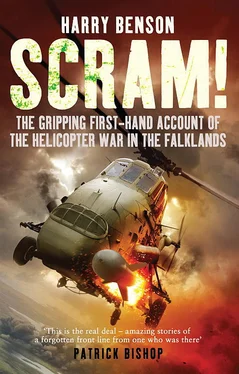He had no idea that this was exactly what was to happen for real.
‘Where are the Falklands? Off Scotland?’ she replied, echoing the same question that would resound around the country just a few hours later.
At RNAS Yeovilton the following day, the phones were ringing red hot. Squadron commanding officers had been instructed to recall their aircrew, many of whom had just left for Easter leave, in response to news of the early morning invasion of the Falkland Islands by Argentine special forces. In 845 Squadron staff office, commanding officer Lieutenant Commander Roger Warden, senior pilot Lieutenant Commander Mike Booth and air engineering officer Lieutenant Commander Peter Vowles discussed their plans. The initial requirement was to assign crews and aircraft and send them off as detachments as soon as possible. For a commando squadron, this was bread-and-butter stuff. As well as frequently rotating aircraft and crews to and from Northern Ireland, there were regular detachments of either two or four aircraft to land bases in Norway or Germany and to various Royal Navy and Royal Fleet Auxiliary ships.
As air engineer officer, Vowles was primarily concerned with the usable hours available on each airframe, gearbox and engine. All helicopter parts have a limited lifespan before needing replacement or overhaul. His expertise lay in assigning the right aircraft and components based on their remaining life and likely use. The maintainers in each detachment would take with them a ‘flyaway pack’ of plastic boxes filled with basic parts and a spare engine.
While Vowles sorted out aircraft availability, Mike Booth’s first conversation was with Lieutenant Nick Foster. Foster and his flight had returned a few weeks earlier from Northern Ireland and were about to go on leave. Instead they were told to get themselves and two aircraft ready to embark in a Belfast transport aeroplane and head on down to Ascension Island on the equator. His second conversation was a phonecall to Lieutenant Commander Jack Lomas at home. ‘Jack, I want you back asap to take a pair of gunships up to Resource in Rosyth. You’re going with Oily.’
Lieutenant Dave ‘Oily’ Knight had recently returned from Norway and was also at home, mixing concrete out in the sunshine for a new patio. ‘Drop everything, Oily. Get your arse back to Yeovilton. You’re off to Scotland tonight,’ Booth told him. The patio would have to wait.
Along the corridor at Yeovilton, 846 Squadron commanding officer Lieutenant Commander Simon Thornewill was also pulling his team together at short notice. He had been telephoned at home at two in the morning and told to get his squadron of Sea Kings onto the aircraft carrier HMS Hermes the same day. The Sea King crews had also just returned from detachments, this time to the north of England and the North Sea. With his senior pilot Lieutenant Commander Bill Pollock and air engineer Lieutenant Commander Richard Harden, they had assembled the squadron aircrew for a brief. Even with crews readily available, departure of the whole squadron in one day was a tough call. The more realistic plan was to embark the following day.
During the day, Simon Thornewill took a phone call from fellow test pilot, Lieutenant Commander Mike Spencer, at the Royal Aircraft Establishment Farnborough. Spencer had been testing out the latest generation of night vision goggles and invited Thornewill to come up to Farnborough and try them out.
By late afternoon, the first Wessex was ready to leave Yeovilton for Rosyth, the Royal Navy base in Edinburgh. At the controls of callsign Yankee Tango, Oily Knight taxied out to ‘point west’, the standard take-off point for helicopters at Yeovilton. Within an hour of lifting off, he was followed by Jack Lomas in Yankee Hotel. Darkness fell as Lomas passed Newcastle on the flight north. An air traffic controller wondered why they were flying so late on a Friday night. ‘Can’t say,’ replied Lomas, whereupon the well-wishing controller burst into song: ‘Don’t cry for me Argentina…’. Both aircraft embarked safely on the flight deck of the Royal Fleet Auxiliary supply ship Resource late that night. The aircraft weapon platforms and other equipment were on their way up by truck.
The next morning, a bemused Lomas was summoned to fly all the way back down from Scotland to Plymouth on a Heron aircraft for an embarkation meeting with representatives from 3 Commando Brigade Royal Marines and Commodore Amphibious Warfare (COMAW). There Lomas was relieved to see the familiar faces of fellow junglies Simon Thornewill and Lieutenant Commander Tim Stanning, his former Wessex boss, who was now in charge of helicopter tasking for COMAW.
To Lomas, the meeting seemed a shambles. ‘In essence, we haven’t a clue how we’re going to do this,’ he thought; ‘but let’s get everything onto the ships, do our planning and exercising on the way down there, and sort out all the kit onto the right ships when we get to Ascension.’
It may have been shambolic. But it was all that was needed.
* * *
On Saturday 3 April, Simon Thornewill led the first nine Sea Kings out from Yeovilton heading towards Portsmouth, staggering their departure so as not to arrive all at once on the already-frantic flight deck of the carrier Hermes . The following evening, three of his most experienced pilots were sent off to join Mike Spencer and Lieutenant Pete Rainey at Farnborough to test out the night vision goggles. Each pilot spent forty-five minutes flying around the darkness of Salisbury Plain in the left-hand seat of a specially adapted Puma helicopter under Spencer’s instruction. The Sea King pilots couldn’t believe how good the goggles were. They were all able to make a few landings in complete darkness. The pilots returned to Hermes at three in the morning along with seven sets of goggles and Pete Rainey to teach them how to use them.
Days later, Pollock and his three Sea Kings embarked for the South Atlantic on the assault ship HMS Fearless at Portland.
Back at Yeovilton, Mike Booth and Peter Vowles were busy assigning the next three Wessex flights. They were now sleeping on camp beds in the office as calls were coming in throughout day and night, amending embarkation requirements, particularly the armament pack – what guns, missiles or rockets were needed. Six more Wessex were being stripped down ready to be moved to Ascension in the back of the Belfast transport aircraft now parked on the dispersal in front of the squadron offices. In a flurry of activity, the first two Wessex – Yankee Delta and Yankee Sierra – departed Yeovilton on Sunday 4 April. Nick Foster and his team flew in an accompanying RAF Hercules. The next few days saw Mike Tidd and his team, along with the ill-fated Yankee Foxtrot and Yankee Alpha, set off in another Belfast and Hercules, while Roger Warden and his team set off with Yankee Juliett and Yankee Kilo.
Within a week, thirteen Sea Kings and eight Wessex had been successfully despatched from Yeovilton for the South Atlantic, each of them folded up and squeezed into the back of transport aircraft.
From the sea, Ascension Island looks a bit like Treasure Island. A huge mountain grows out from its centre. It really ought to be a tropical paradise. Unfortunately, setting foot on the island immediately dispels the illusion. The landscape is mostly dusty and brown. The ground is unforgiving, made of volcanic rock that would happily skin the soles off your feet. Ascension is little more than a giant lump of volcanic rock parked in the middle of the Atlantic Ocean just south of the equator. It was first garrisoned by the British in 1815 as a precaution after Napoleon was imprisoned on St Helena.
In 1982 Ascension Island was an ideal halfway staging post along the 8,000-mile journey from the UK to the Falklands and therefore the initial target for all ships and aircraft. As a British protectorate, Wideawake airfield and its giant runway was loaned out to the US military and NASA. On 5 April, Nick Foster and his flight were the first Brits to arrive in Ascension. Although made welcome by the American base staff, they had no spare bedding or accommodation and so spent the first couple of nights sleeping under pool tables.
Читать дальше












